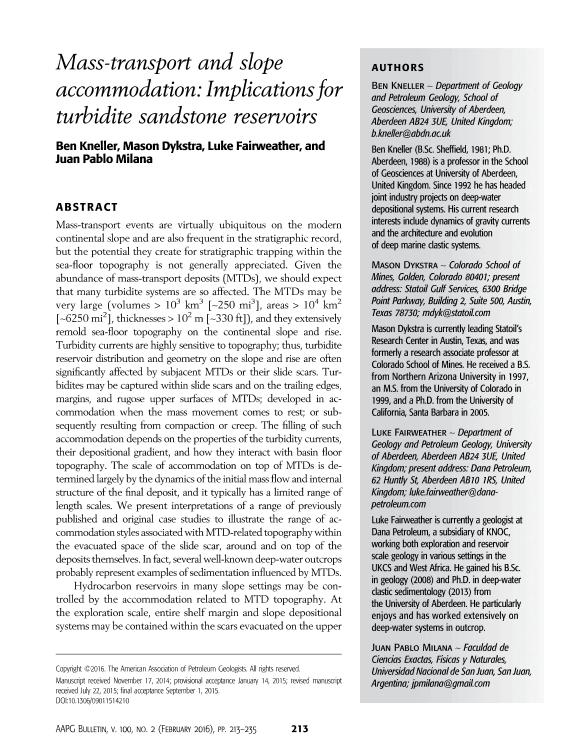Mostrar el registro sencillo del ítem
dc.contributor.author
Kneller, Ben
dc.contributor.author
Dykstra, Mason
dc.contributor.author
Fairweather, Luke
dc.contributor.author
Milana, Juan Pablo

dc.date.available
2018-09-28T19:20:21Z
dc.date.issued
2016-02
dc.identifier.citation
Kneller, Ben; Dykstra, Mason; Fairweather, Luke; Milana, Juan Pablo; Mass-transport and slope accommodation: Implications for turbidite sandstone reservoirs; American Association of Petroleum Geologists; AAPG Bulletin; 100; 2; 2-2016; 213-235
dc.identifier.issn
0149-1423
dc.identifier.uri
http://hdl.handle.net/11336/61281
dc.description.abstract
Mass-transport events are virtually ubiquitous on the modern continental slope and are also frequent in the stratigraphic record, but the potential they create for stratigraphic trapping within the sea-floor topography is not generally appreciated. Given the abundance of mass-transport deposits (MTDs), we should expect that many turbidite systems are so affected. The MTDs may be very large (volumes > 103 km3 [∼250 mi3], areas > 104 km2 [∼6250 mi2], thicknesses > 102 m [∼330 ft]), and they extensively remold sea-floor topography on the continental slope and rise. Turbidity currents are highly sensitive to topography; thus, turbidite reservoir distribution and geometry on the slope and rise are often significantly affected by subjacent MTDs or their slide scars. Turbidites may be captured within slide scars and on the trailing edges, margins, and rugose upper surfaces of MTDs; developed in accommodation when the mass movement comes to rest; or subsequently resulting from compaction or creep. The filling of such accommodation depends on the properties of the turbidity currents, their depositional gradient, and how they interact with basin floor topography. The scale of accommodation on top of MTDs is determined largely by the dynamics of the initial mass flow and internal structure of the final deposit, and it typically has a limited range of length scales. We present interpretations of a range of previously published and original case studies to illustrate the range of accommodation styles associated with MTD-related topography within the evacuated space of the slide scar, around and on top of the deposits themselves. In fact, several well-known deep-water outcrops probably represent examples of sedimentation influenced by MTDs. Hydrocarbon reservoirs in many slope settings may be controlled by the accommodation related to MTD topography. At the exploration scale, entire shelf margin and slope depositional systems may be contained within the scars evacuated on the upper slope by mass failure, whereas at the production scale, the rugosity on the top of MTDs creates widespread potential for stratigraphic trapping. The location, geometry, and property distribution of such reservoirs are closely controlled by the interaction of turbidity currents with the topography; thus, an understanding of these processes and their impact on slope stratigraphy is vital to reservoir prediction.
dc.format
application/pdf
dc.language.iso
eng
dc.publisher
American Association of Petroleum Geologists

dc.rights
info:eu-repo/semantics/openAccess
dc.rights.uri
https://creativecommons.org/licenses/by-nc-sa/2.5/ar/
dc.subject
Mass Tranbsport Deposits
dc.subject
Oil Exploration
dc.subject
Deep Water Processes
dc.subject.classification
Meteorología y Ciencias Atmosféricas

dc.subject.classification
Ciencias de la Tierra y relacionadas con el Medio Ambiente

dc.subject.classification
CIENCIAS NATURALES Y EXACTAS

dc.title
Mass-transport and slope accommodation: Implications for turbidite sandstone reservoirs
dc.type
info:eu-repo/semantics/article
dc.type
info:ar-repo/semantics/artículo
dc.type
info:eu-repo/semantics/publishedVersion
dc.date.updated
2018-09-27T20:25:51Z
dc.journal.volume
100
dc.journal.number
2
dc.journal.pagination
213-235
dc.journal.pais
Estados Unidos

dc.journal.ciudad
Tulsa
dc.description.fil
Fil: Kneller, Ben. University of Aberdeen; Reino Unido
dc.description.fil
Fil: Dykstra, Mason. Colorado School of Mines; Estados Unidos
dc.description.fil
Fil: Fairweather, Luke. University of Aberdeen; Reino Unido
dc.description.fil
Fil: Milana, Juan Pablo. Consejo Nacional de Investigaciones Científicas y Técnicas. Centro Científico Tecnológico Conicet - San Juan. Centro de Investigaciones de la Geosfera y Biosfera. Universidad Nacional de San Juan. Facultad de Ciencias Exactas Físicas y Naturales. Centro de Investigaciones de la Geosfera y Biosfera; Argentina
dc.journal.title
AAPG Bulletin

dc.relation.alternativeid
info:eu-repo/semantics/altIdentifier/doi/http://dx.doi.org/10.1306/09011514210
dc.relation.alternativeid
info:eu-repo/semantics/altIdentifier/url/http://archives.datapages.com/data/bulletns/2016/02feb/BLTN14210/BLTN14210.html?doi=10.1306%2F09011514210
Archivos asociados
